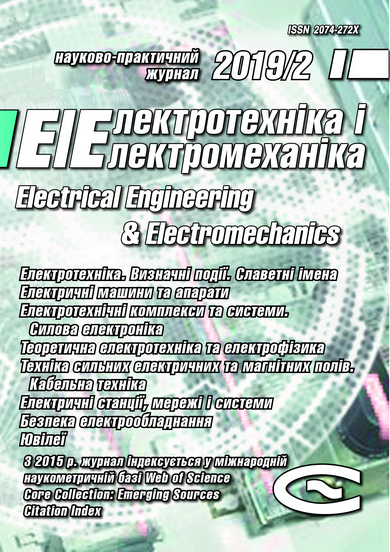RESEARCH OF DYNAMIC CHARACTERISTICS OF INDUCTION MOTORS IN ELECTRIC DRIVES WITH MATCHING TRANSFORMER AND REDUCER
DOI:
https://doi.org/10.20998/2074-272X.2019.2.03Keywords:
induction motor, load cyclogram, reducer, transformer, mathematical model, average cyclic criteria, energy indicators, reduced costsAbstract
Introduction. The variety of electric drives, the performance characteristics of which correspond to the set requirements of consumers while ensuring reliable and economical operation for a certain time resource, characterizes the variety of circuit solutions, including using matching transformers and reducers. Problem. The use of matching transformers and reducers units significantly changes the performance characteristics of the electric drive. Most articles are devoted to modeling an electric drive without such elements. It is advisable to consider simulations of electric drives using these elements. Methodology. In the models of matching transformers and reducers, the initial data are used, which determine both the functional properties and the mass and size parameters. The latter provide an opportunity to consider the economic aspects of the electric drive. For the correct calculation of the energy balance of the electric drive, the efficiency of the elements under consideration is taken into account. Results. The use of the developed algorithms for modeling the dynamic modes of two induction motors in electric drives operating on a specific load diagram, with the connection of a matching transformer and reducers, is considered. Dependencies of efficiency and power factor of motors have allowed to determine the medium cyclic energy indicators. The mass- size and cost indicators of variants of electric drives were found, which made it possible to calculate the average cyclic reduced costs of electric drives. Practical value. The possibility of choosing the best variant of the drive based on various indicators, including the minimum amount of energy losses per year, is substantiated.References
IEC 60034-1:2004. Rotating electrical machines – Part 1: Rating and performance.
Bespalov V.Y., Dunaykina E.A. Moshchinskii Y.A. Nestatsionarnye teplovye raschety v elektricheskih mashinah [Unsteady heat calculations in electrical machines]. Moscow, MEI Publ., 1987. 72 p. (Rus).
Dunaykina E.A. Razrabotka modifikatsii asinkhronnykh dvigatelei edinoi serii 4A (H = 56-132 mm) dlia kratkovremennykh rezhimov. Avtoref. diss. kand. tekhn. nauk [Development modifications asynchronous motors single series 4A (H = 56-132 mm) for the short-term operation. Abstracts of cand. tech. sci. diss.]. Moscow, 1986. 20 p. (Rus).
Nyein Nyein Soe, Thet Thet Han Yee, Soe Sandar Aung. Dynamic Modeling and Simulation of Three-phase Small Power Induction Motor. World Academy of Science, Engineering and Technology, 2008, no.42, pp. 421-424.
Verbovoi A.P., Verbovoi P.F. Problems of modeling of transient electromagnetic processes in asynchronous machines. Technical electrodynamics. Thematic issue «Problems of modern electrical engineering», 2004, chapter 2, pp. 65-70. (Rus).
Kopylov I.P. Matematicheskoe modelirovanie elektricheskih mashin [Equipment of the electrode plants mathematical modeling of electrical machines]. Moscow, High School Publ., 1987. 248 p. (Rus).
Petrushin V.S. Asinhronnye dvigateli v reguliruemom elektroprivode: Uchebnoe posobie [Induction motors in adjustable electric: Textbook]. Odessa, Nauka i tehnika Publ., 2006. 320 p. (Rus).
Zhao C., Ren Z., Zhou X., Wen B. The Online Monitoring of the Dynamic Characteristics for an Induction Motor and Gearbox Transmission System. Second International Conference on Innovative Computing, Informatio and Control (ICICIC 2007), Kumamoto, 2007. pp. 532-532. doi: 10.1109/ICICIC.2007.582.
Evon S., Schiferl R. Direct-drive induction motors: using an induction motor as an alternative to a motor with reducer. IEEE Industry Applications Magazine, 2005, vol.11, no.4, pp. 45-51. doi: 10.1109/MIA.2005.1458276.
Rojas-Moreno A. Parameter extraction of an induction motor with gearbox for dynamic simulation. 2016 IEEE ANDESCON, pp. 1-4. doi: 10.1109/ANDESCON.2016.7836207.
Shwehdi M.H., Hye A., Quasem M.A. Economic analysis and evaluation of transformer and induction motor losses costs using PC software. 1993 (25th) Southeastern Symposium on System Theory, pp. 63-67. doi: 10.1109/SSST.1993.522743.
Petrushin V.S., Ryabinin S.V., Yakimets A.M. Analysis of losses and thermal state of an asynchronous motor in frequency control. Works of the Institute of Electrodynamics of the National Academy of Sciences of Ukraine, 1999, no.1, pp. 31-36. (Rus).
Petrushin V.S., Bendahmane Boukhalfa, Yakimets A.M., Kalenik O.V. Influence of magnetic core steel saturation and rotor current displacement on dynamic characteristics of adjustable-speed induction motors. Electrical Engineering & Electromechanics, 2010, no.2, pp. 21-23. (Rus). doi: 10.2098/2074–272X.2010.02.06.
Tonkal V.E., Novoseltsev A.V., Denisiuk S.P. Balans energii v silovykh tsepiakh [Balance of energies in power circuits]. Kiev, Naukova dumka Publ., 1992. 312 p. (Rus).
Rodkin D.I. The balance of the components of the instantaneous power of polyharmonic signals. Transactions of Kremenchuk Mykhailo Ostrohradskyi National University, 2007, no.3(44), part 1, pp. 66-71. (Rus).
Orlovskii I.A. On the power in an electrical circuit with a valve. Works of the Tavria State Agrotechnological University, 2013, no.13, vol.4, pp. 141-150.
Petrushin V.S., Rjabinin S.V., Yakimets, A.M. Programmnyj produkt «DIMASDrive». Programma analiza raboty, vybora i proektirovanija asinhronnyh korotkozamknutyh dvigatelej sistem reguliruemogo elektroprivoda [Program performance analysis, selection and design of asynchronous cage motors controlled drive systems]. Patent UA, no.4065. (Ukr).
Downloads
Published
How to Cite
Issue
Section
License
Copyright (c) 2019 V. S. Petrushin, Y. R. Plotkin, R. N. Yenoktaiev, N. S. Prokopenko

This work is licensed under a Creative Commons Attribution-NonCommercial 4.0 International License.
Authors who publish with this journal agree to the following terms:
1. Authors retain copyright and grant the journal right of first publication with the work simultaneously licensed under a Creative Commons Attribution License that allows others to share the work with an acknowledgement of the work's authorship and initial publication in this journal.
2. Authors are able to enter into separate, additional contractual arrangements for the non-exclusive distribution of the journal's published version of the work (e.g., post it to an institutional repository or publish it in a book), with an acknowledgement of its initial publication in this journal.
3. Authors are permitted and encouraged to post their work online (e.g., in institutional repositories or on their website) prior to and during the submission process, as it can lead to productive exchanges, as well as earlier and greater citation of published work.





